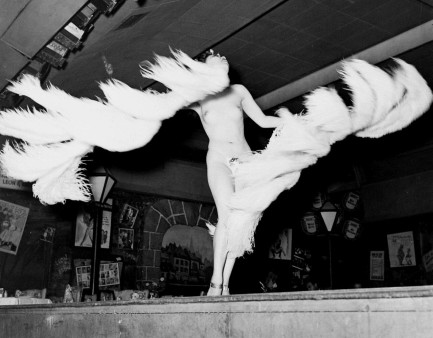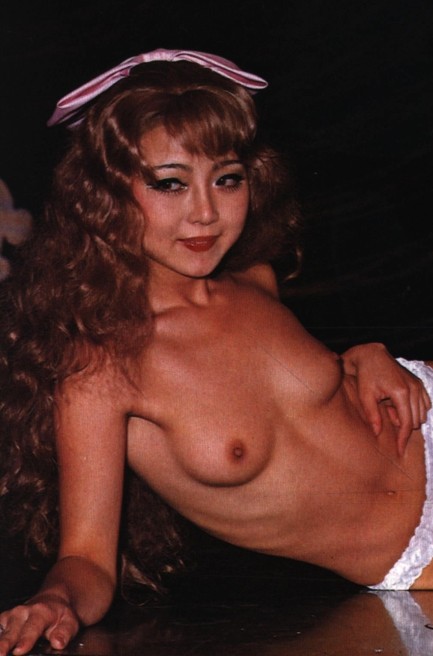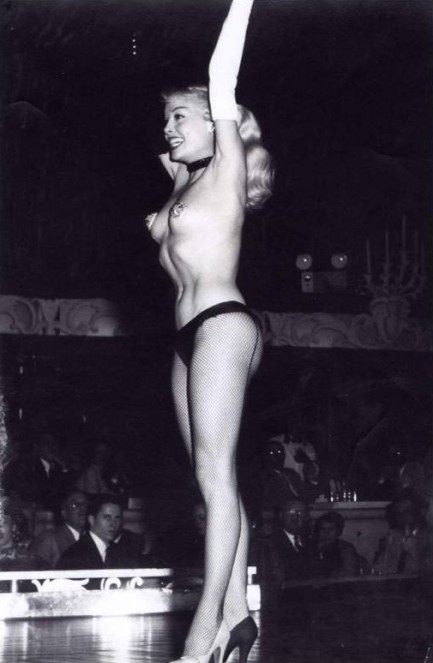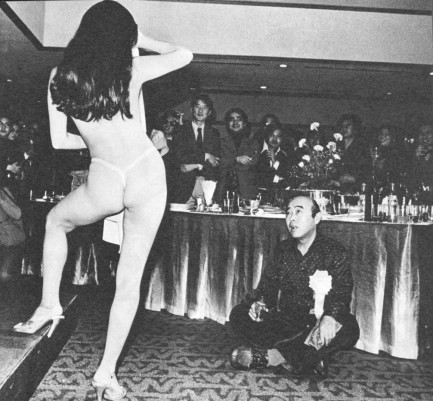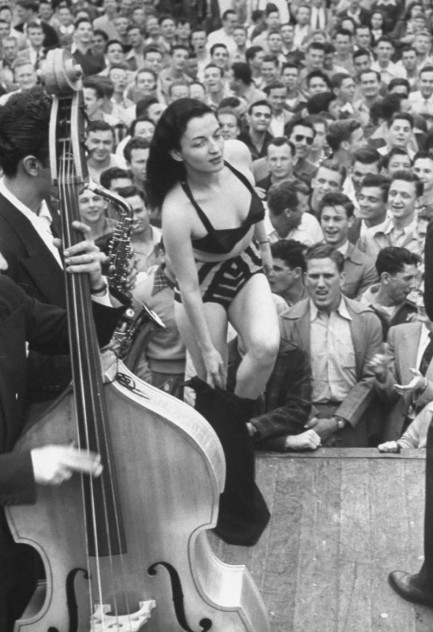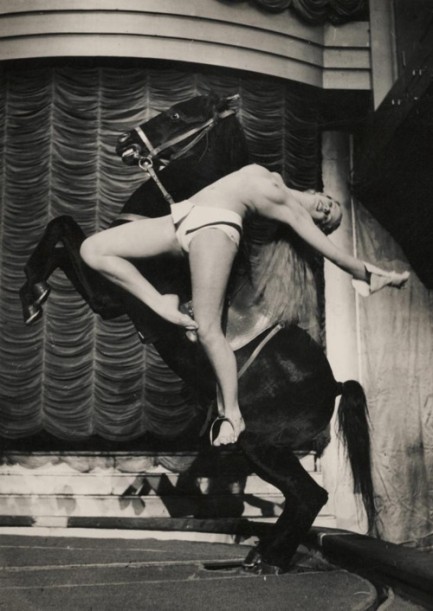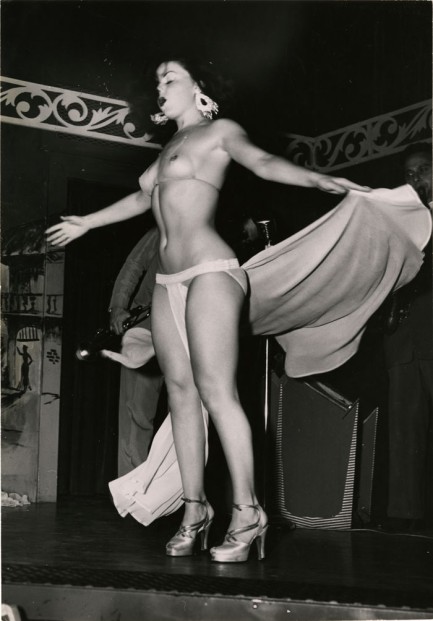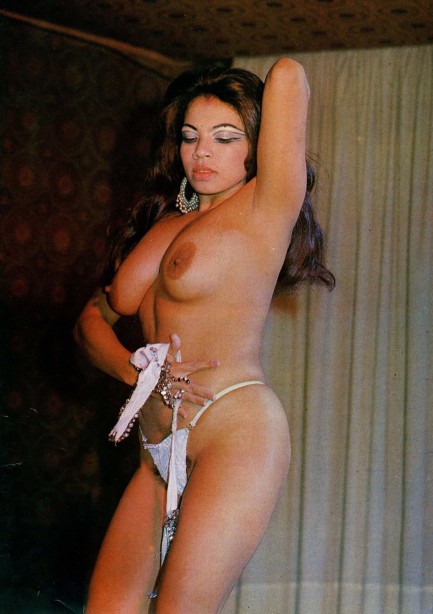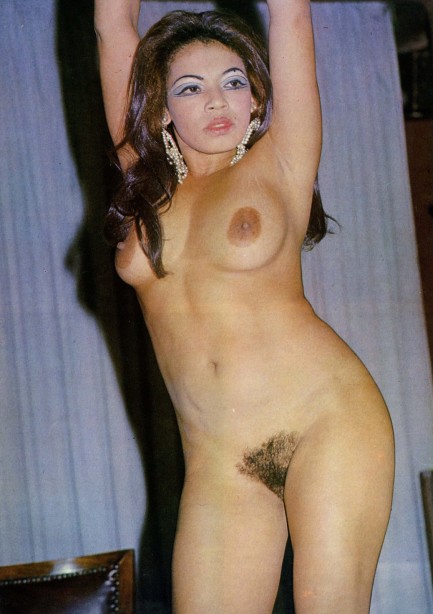 The anatomy and the ecstasy.  
We have a tremendous amount of material on burlesque in Pulp Intl., yet it's been eight years since we put together a full collection of mid-century burlesque dancers, go-go girls, and strippers. That day has arrived again. Above and below you see some of the better shots we've run across of late, featuring the famous and the obscure, the restrained and the explicit, the domestic and the foreign, and the blonde, red, brown, and brunette. Where possible we've identified the performer, such as above—that's Carol Ryva, sometimes known as Carol Riva, Carole von Ryva, Cara Rive, et al, a French dancer who rose to fame during the early 1960s. Other familiar faces you'll see are Lilly Christine, Maria Tuxedo, Gay Dawn, Yvonne Ménard, and Virginia Bell. Occasionally, when we post something that contains nudity, we feel, in this age of new puritanism that we should comment about it. We saw a survey recently indicating that a large percentage of Gen Z'ers think nudity in movies is unnecessary in all circumstances, especially sex scenes. And we're like, really? The wonderful thing that virtually every person does, or which practically everyone wants to do, and which is how nearly all of us came to be here on the planet, is somehow taboo, but the horrible thing that virtually none of us do—kill—must be part of nearly every film, book, and television show? Programming works. If you sell sexual shame unceasingly new generations will absorb it, and believe they've come to their views organically.
The reality is that sex and nudity are freeing. Burlesque and erotic dance are valuable because they take our DNA driven sexual desire and package it as an art form, fit for public consumption and contemplation. Moving one's body rhythmically feels good, and watching those who work so very hard but make look so easy the pushing of their physical limits within the realm of such expression is pleasing to the eye and psyche. That's why we love erotic dance. Our two previous burlesque collections, “Infinite Jest,” and “Dancers Gotta Dance,” are here and here, and we have some notable smaller burlesque forays here, here, and here. But if you want to kill some time for real, instead click the keyword “burlesque” at bottom, then scroll, scroll, scroll. Make sure you pack a lunch. Virginia Bell
Lee Sharon.
Dixie Brandy.
A group shot from the legendary Crazy Horse, Paris.
The incomparable Lilly Christine. We also have a set of photos from one of her performances here, and more links from that point.
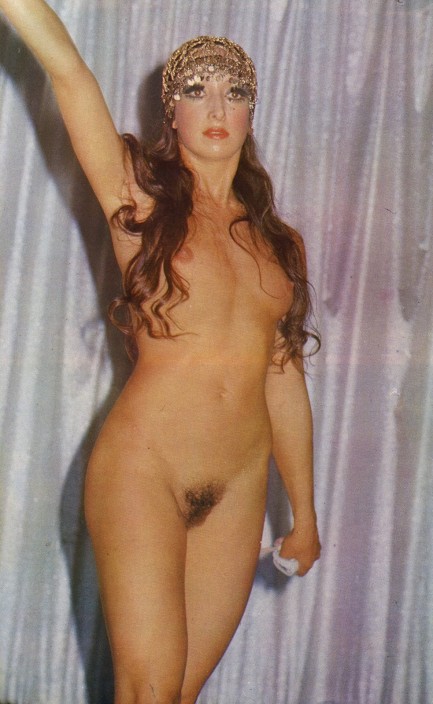 
The Follies Theater at 337 S. Main Street, Los Angeles, 1946.
Tempest Storm.
Gay Dawn.
Yvonne Ménard, and more photos here.
Carol Jane, aka Spider Woman.
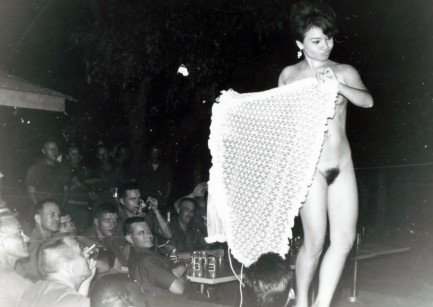 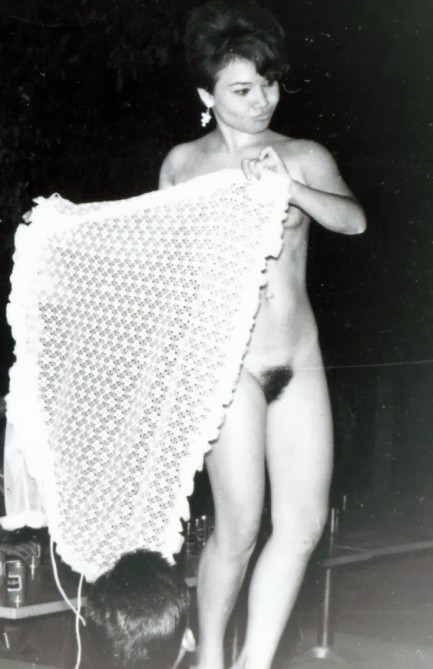 Jackie Miller.
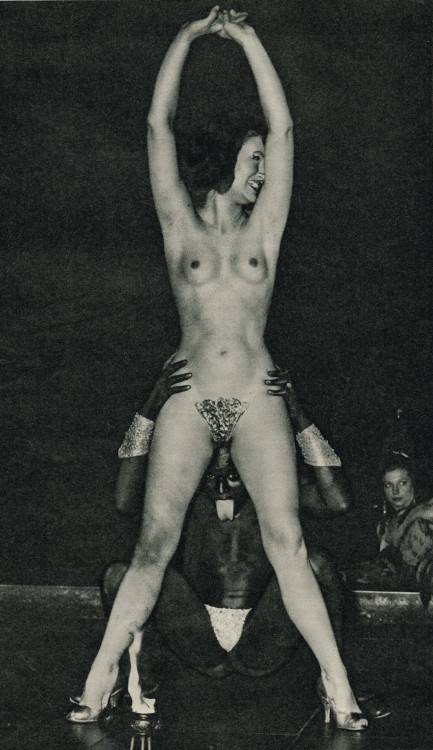 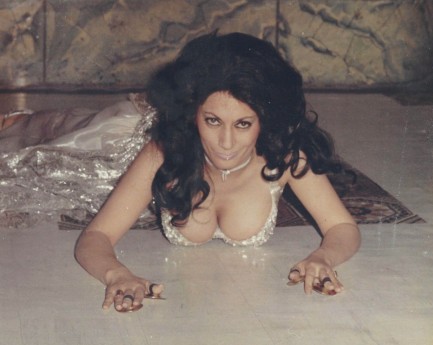  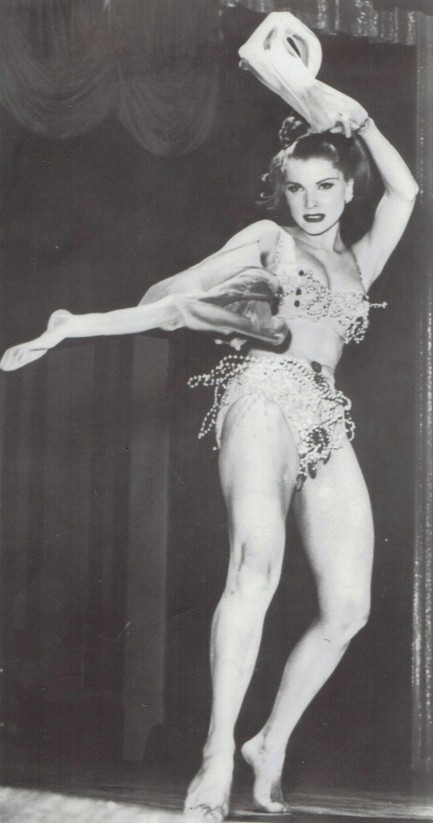 Debra Paget, who performed one of the most provocative screen dances ever in 1959's De indische grabmal. Debra Paget, who performed one of the most provocative screen dances ever in 1959's De indische grabmal.
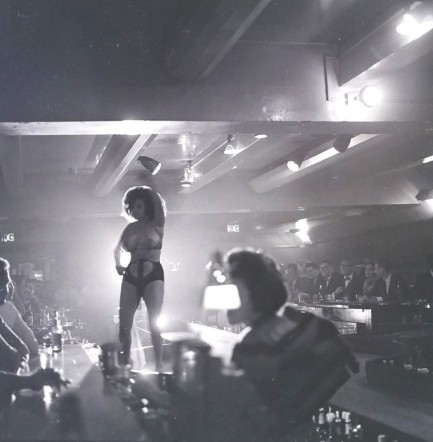 Blaze Starr. We also saw her recently here. Blaze Starr. We also saw her recently here.  
 I'm starting to get a very bad feeling about this. 
This beautiful dust jacket for Mark Derby's The Tigress was painted by the very talented British artist John Rose for William Collins Sons & Co. in 1959. You'll remember that we already did a deep dive into Mark Derby's Womanhunt a bit ago. This is the same novel under its original title. Interesting, isn't it, that for U.S. readers the decision-makers at Ace Books thought Womanhunt was a better title? In any case, it's a very good novel.
 Hi there, convict. How'd ya like to perform a cavity search for a change?  
We've been eyeing a Russell Trainer novel called His Daughter's Friend for a while. It has one of illustrator Paul Rader's best covers. But since it's a pretty empty feeling to buy a book with a nice cover that turns out to be terribly written (often the case with sleaze novels), we wanted to sample Trainer's prose. With the price of His Daughter's Friend running as high as $200.00, a trial run was needed on cheaper books. Incidentally, we'd never pay that for a book anyway, but if Trainer can write, we'd probably go as high as $30.00, if we ever found a copy at that price. We ended up buying two Trainers, both at around fifteen bucks. You see the first above—Jail Bait. It's an Australian edition published by New Century Press without a copyright date or cover artist attribution. Originally it appeared in the U.S. and Canada in 1962 as The Warden's Wife.
That title pretty much sums up the idea behind the book, as a felon named Eddie Koski, after three years in max, is made a trustee and given a form of freedom as he works around the prison for the warden and other high ranking corrections officials. Unfortunately, the warden's smoking hot wife Thelma is keenly interested in working Eddie's shlong, which, of course, can only lead to trouble, if not more jail time. Things become doubly complicated when Eddie falls for a beautiful sociologist who comes to the prison to work on a dissertation. Can he escape the clutches of the dangerous Thelma and find love and freedom? Perhaps. The book is fun for the most part, but we'd have preferred the story to conclude without its late turn toward vicious homophobia. We weren't surprised when it happened, though. Consider yourselves forewarned.
Overall, we wouldn't say Jail Bait is either great or awful, which means Trainer probably will fail to add value to His Daugher's Friend. While we often buy books entirely for the cover art, we never buy expensive ones for that reason. What we love is a book that surpasses our expectations, like, for example, Val Munroe's surprisingly good 1952 sleazer Carnival of Passion. We suppose requiring decent writing skill with the cover art makes us amateurs at the book collecting game, but we're not really collectors anyway. We'll never sell them, in all likelihood. Nearly all the buyers would be in the U.S., and mailing them overseas, even at a profit, is too much work to even contemplate. So we'll give up our quest for His Daughter's Friend unless Trainer knocks book two—1963's No Way Back—completely out of the park. We'll read it in a bit and see where matters stand. 
 Sights, sounds, and sentiments from the thirty-four countries that made up the Europe of the time. 
Above is the cover of the July 1967 issue of Continental Film Review, a magazine produced by London based Eurap Publishing, which updated readers on the latest developments in European cinema. This issue focuses on the Netherlands, Yugoslavia, Sweden, Greece, Italy, and the Cannes Film Festival.
Here's an interesting quote from within: An indication of Italy's mammoth production appeared in an Italian trade journal a few weeks back which listed thirty-eight films premiered in the previous few weeks, seventy-six ready to be premiered, twenty being edited, forty-four in production, twenty-one about to start shooting and thirty-one being prepared, making a total of 230 films (including, of course, co-productions).
You probably think that's an enormous number, but last year Italy released 356 films. It's amazing how much there is to see from other countries if you care to look, and that's largely what Continental Film Review was about. We have twenty-plus scans below, and other issues scattered here and there in places around the website.
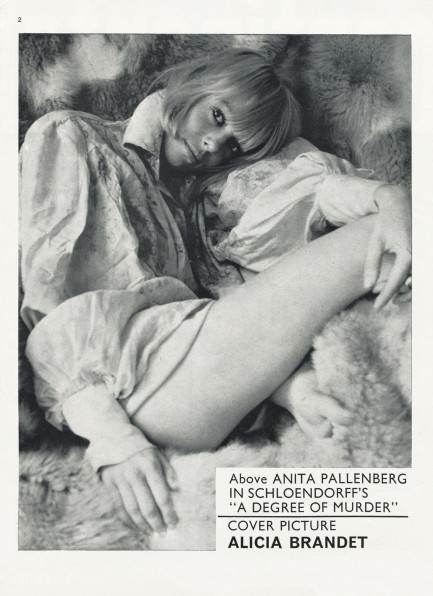                         
 Your usual server won't be with you tonight. She's come down with a small case of murder. 
The Swinging Barmaids, which splashed across U.S. screens for the first time this month in 1975, is one of those movies with a deliberately misleading title. Rather than the breezy erotic romp you'd expect, it's a thriller about an insane serial killer who stalks a group of waitresses working in a Los Angeles go-go bar. The problems commence when Dyanne Thorne (yes, she made movies aside from the Ilsa atrocities) is stabbed to death, setting off an inept police investigation, while the killer sets his crazy sights on more victims. He's the classic maladjusted loner you find in ’70s grindhouse filcks. You know the type: “You're the first girl I ever met that wasn't dirty underneath.” What type of woman wouldn't immediately leave town after hearing something like that? Answer: a woman in a bad movie. Eventually, to facilitate his homicidal efforts, Mr. Maladjustment gets a job as a dishwasher at the bar. More killings eventually lead to the unveiling of this wolf in the fold, and his inevitable perforation with 12-gauge buckshot. That isn't a spoiler. His death is the entire point of the film. Well, that and boobs. But the problem is that this is all mounted perfunctorily, is poorly written, visually lackluster, narratively sluggish, and devoid of actorly charisma. In fact, if not for the nudity, you'd think The Swinging Barmaids was a minor television movie. The best thing going for it is the above poster art by the incomparable John Solie. Check, please.
        
 And she didn't even need a password to do it. 
Japanese actress Noriko Yamamoto was a minor player onscreen, but she's a major player on this log in a photo published in a 1980 issue of Heibon Punch. It's a nice image, part of an essay shot in Alaska, of all places. Here's what she said about it (so claimed the editors): “The clock is pointing to 11 PM, but the red sun is bright and beautiful. Anxiety crossed my mind as to whether I would be able to survive in this great outdoors. Fishing with a lure for the first time after setting up the tent. And the feeling of a king salmon coming into my hand. A river as wide as a lake. I don't know when bears will come out, making my heart flutter.” Despite her fears she survived, there were no bears, and most importantly she suffered no splinters. Bonus: she got to hold a humungous fish.

 Darlin', that what happens here stays here stuff is baloney. What happens next—I guarantee—will stay with you forever. 
Above: uncredited sleaze cover work from Nite Time Books for Scott Rainey's 1964 alternative lifestyle romp Las Vegas Lesbian. The back says: She was a beautiful desirable woman in a gambling town loaded with women. But there was a difference. She wanted to destroy every man—and woman—who wouldn’t play the game her way! Our advice: play the game exactly as she wishes. It would be the only game in Vegas where both sides win.
 Waugh elevates missing person procedurals to a new level. 
Reading mid-century crime and adventure novels has been a great journey for us. We can imagine those who've already read them smiling (or smirking) as we discuss the books as revelations. “These pulp guys. *eye roll* ’Bout seventy years late with their stunning insights.” But that's the way it goes—you have start sometime. Over the years we've gone from novice to slightly-less-novice in this realm.
We say all that because, though Hillary Waugh is a well-known novelist, up to this week we'd read only one of his books—1960's The Girl Who Cried Wolf. It's a personality-driven, occasionally cute tale, about a tough P.I. and the collegiate client who has a massive crush on him. The book is pretty much a total success. There was no logical reason for us think that single effort defined Waugh's style, but experience has shown that a good novel tends to sits in the sweet spot of an author, and they hit those notes again and again.
Imagine our surprise, then, when we read 1954's Last Seen Wearing and discovered that it's a stark police procedural allegedly inspired by the true 1946 disappearance of 18-year-old Bennington College student Paula Jean Welden. What Waugh produces is basically impossible to put down. If you like police procedurals, read this one. Waugh wows. Also wow is the cover art on the 1960 Great Pan edition. Uncredited though.
 I have smaller ones, but we don't know each other that well yet. 
This fun promo image shows U.S. actress Claire Dodd and was made for the 1930 pre-Code comedy Whoopee! It was only her second film appearance and she was uncredited, but she went on to feature in more than sixty movies between 1930 and 1942, including the original version of The Glass Key. This behind-the-hat pose was quite popular back in her day. We've seen at least five or six performers from the ’30s doing it. Maybe we'll put together a collection later.
 In all Modesty, she was one of the best fictional spies of her era.  
This nice off-center watercolor shows the iconic comic strip spy Modesty Blaise, and was painted by Jim Holdaway, possibly as he was finalizing the look of the character in collaboration with author Peter O'Donnell before premiering her in the London Evening Standard in May 1963. He illustrated Modesty's adventures for seven years, until felled by a heart attack. O'Donnell wrote a series of Modesty Blaise novels, expanding them in a slightly more adult direction, which made them about as much fun as lightweight, espionage oriented boner bait could be. We've talked about the movie and several of the books, so if you're curious just click the keywords “Modesty Blaise” below and scroll.

|
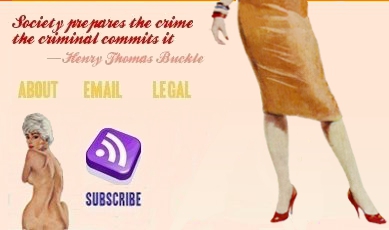 |

The headlines that mattered yesteryear.
2003—Hope Dies
Film legend Bob Hope dies of pneumonia two months after celebrating his 100th birthday. 1945—Churchill Given the Sack
In spite of admiring Winston Churchill as a great wartime leader, Britons elect
Clement Attlee the nation's new prime minister in a sweeping victory for the Labour Party over the Conservatives. 1952—Evita Peron Dies
Eva Duarte de Peron, aka Evita, wife of the president of the Argentine Republic, dies from cancer at age 33. Evita had brought the working classes into a position of political power never witnessed before, but was hated by the nation's powerful military class. She is lain to rest in Milan, Italy in a secret grave under a nun's name, but is eventually returned to Argentina for reburial beside her husband in 1974. 1943—Mussolini Calls It Quits
Italian dictator Benito Mussolini steps down as head of the armed forces and the government. It soon becomes clear that Il Duce did not relinquish power voluntarily, but was forced to resign after former Fascist colleagues turned against him. He is later installed by Germany as leader of the Italian Social Republic in the north of the country, but is killed by partisans in 1945.
|
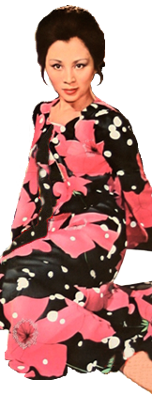
|
|
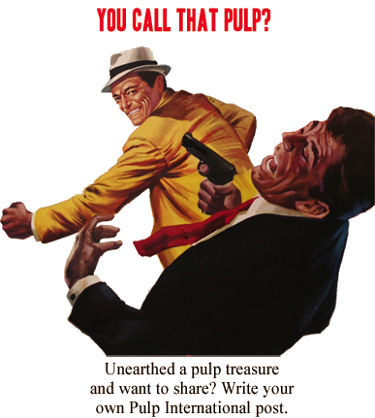
It's easy. We have an uploader that makes it a snap. Use it to submit your art, text, header, and subhead. Your post can be funny, serious, or anything in between, as long as it's vintage pulp. You'll get a byline and experience the fleeting pride of free authorship. We'll edit your post for typos, but the rest is up to you. Click here to give us your best shot.

|
|





